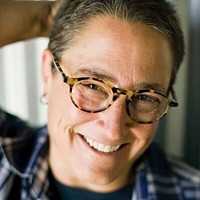Wednesday, June 10, 2020
Symbol of Hate
Posted By Babs De Lay on June 10, 2020, 4:00 AM
Who knew peaceful little Utah would have its own riots sparked by the murder of an African American man held by police officers in Minnesota? Protesters overturned and burned cars, looters broke windows and crowds lobbed water bottles and rocks at police. There were reports of a protester with a bat and another, a hammer. Meanwhile, one white guy pointed a hunting bow and arrow at protesters.
Welcome to Utah 2020. The struggle for equality and human rights is real, not only here but across this country and around the world. This could be another summer when cities are burning from coast to coast, just like in 1968 when Martin Luther King Jr. was murdered.
Amid the marches, graffiti and hovering helicopters, there's another gut-wrenching symbol of violence, aggression and murder that's being removed from a small, almost forgotten graveyard at the University of Utah near the old Fort Douglas Post on Chipeta Way (just south Red Butte Garden).
To many, swastikas dredge up memories of hatred, fear, racial intolerance and genocide going back to when our country had joined with the world in a fight against Nazis during World War II. German nationalists who believed they were descended from a master race embraced the swastika, and the symbol came to be displayed on the Nazi red flags that were marched all over Europe.
Yet, here in an East Bench cemetery, you can find gravestones with swastikas etched into the granite in memory of German soldiers' service for their führer.
This cemetery, which was first opened in 1862, is the final resting place for a number of historic figures: the man who bayoneted Crazy Horse, solders who came to guard the trade routes to California, a governor and multiple prisoners of war, including 21 German sailors captured in World War I, Italian soldiers who served under Mussolini and a Japanese solder captured in World War II.
Nine who are buried here were German prisoners of war held at a camp in Salina, Utah. They were gunned down in 1945 by an American soldier who, while guarding the POWs, went berserk one night and went on a shooting spree, injuring 19 others. Others died of accidents or illnesses in different areas of the state under the watch of U.S. troops.
No one has been buried here since the 1970s. Soon, three headstones will be removed by the Department of Veteran Affairs and placed in the National Cemetery Administration History Collection.
The headstones in question have German military awards/decorations carved into them, including an Iron Cross featuring a swastika within the cross. The VA initially wasn't going to do anything about these markers, but VA Secretary Robert Wilkie has since decided they've got to go. They will be replaced at a later date with grave markers sans swastikas. Advocates in Texas had been urging the secretary to remove Nazi headstones after a retired colonel visited his Jewish grandfather's grave at Fort Sam Houston National Cemetery in San Antonio where two other such grave markers lie.
More by Babs De Lay
-
Americans who think about fleeing to Canada would still have a hard time finding housing.
Urban Living
- Apr 17, 2024
-
A new skyscraper on State Street is one part office tower and one part Latter-day Saint meetinghouse.
Urban Living
- Apr 10, 2024
-
Spring in Salt Lake City means potholes to avoid and construction at Temple Square, Sugar House, the Avenues and more.
Urban Living
- Apr 3, 2024
- More »





